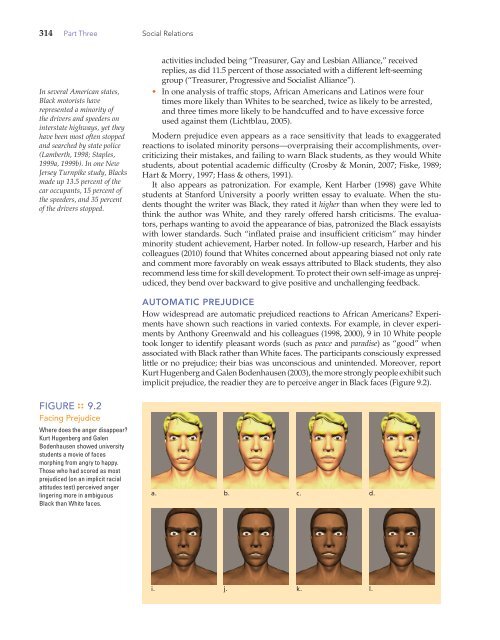Chapter 9: Prejudice: Disliking Others (2947.0K) - Bad Request
Chapter 9: Prejudice: Disliking Others (2947.0K) - Bad Request
Chapter 9: Prejudice: Disliking Others (2947.0K) - Bad Request
Create successful ePaper yourself
Turn your PDF publications into a flip-book with our unique Google optimized e-Paper software.
314 Part Three Social Relations<br />
In several American states,<br />
Black motorists have<br />
represented a minority of<br />
the drivers and speeders on<br />
interstate highways, yet they<br />
have been most often stopped<br />
and searched by state police<br />
(Lamberth, 1998; Staples,<br />
1999a, 1999b). In one New<br />
Jersey Turnpike study, Blacks<br />
made up 13.5 percent of the<br />
car occupants, 15 percent of<br />
the speeders, and 35 percent<br />
of the drivers stopped.<br />
FIGURE :: 9.2<br />
Facing <strong>Prejudice</strong><br />
Where does the anger disappear?<br />
Kurt Hugenberg and Galen<br />
Bodenhausen showed university<br />
students a movie of faces<br />
morphing from angry to happy.<br />
Those who had scored as most<br />
prejudiced (on an implicit racial<br />
attitudes test) perceived anger<br />
lingering more in ambiguous<br />
Black than White faces.<br />
activities included being “Treasurer, Gay and Lesbian Alliance,” received<br />
replies, as did 11.5 percent of those associated with a different left-seeming<br />
group (“Treasurer, Progressive and Socialist Alliance”).<br />
• In one analysis of traffic stops, African Americans and Latinos were four<br />
times more likely than Whites to be searched, twice as likely to be arrested,<br />
and three times more likely to be handcuffed and to have excessive force<br />
used against them (Lichtblau, 2005).<br />
Modern prejudice even appears as a race sensitivity that leads to exaggerated<br />
reactions to isolated minority persons—overpraising their accomplishments, overcriticizing<br />
their mistakes, and failing to warn Black students, as they would White<br />
students, about potential academic difficulty (Crosby & Monin, 2007; Fiske, 1989;<br />
Hart & Morry, 1997; Hass & others, 1991).<br />
It also appears as patronization. For example, Kent Harber (1998) gave White<br />
students at Stanford University a poorly written essay to evaluate. When the students<br />
thought the writer was Black, they rated it higher than when they were led to<br />
think the author was White, and they rarely offered harsh criticisms. The evaluators,<br />
perhaps wanting to avoid the appearance of bias, patronized the Black essayists<br />
with lower standards. Such “inflated praise and insufficient criticism” may hinder<br />
minority student achievement, Harber noted. In follow-up research, Harber and his<br />
colleagues (2010) found that Whites concerned about appearing biased not only rate<br />
and comment more favorably on weak essays attributed to Black students, they also<br />
recommend less time for skill development. To protect their own self-image as unprejudiced,<br />
they bend over backward to give positive and unchallenging feedback.<br />
AUTOMATIC PREJUDICE<br />
How widespread are automatic prejudiced reactions to African Americans? Experiments<br />
have shown such reactions in varied contexts. For example, in clever experiments<br />
by Anthony Greenwald and his colleagues (1998, 2000), 9 in 10 White people<br />
took longer to identify pleasant words (such as peace and paradise ) as “good” when<br />
associated with Black rather than White faces. The participants consciously expressed<br />
little or no prejudice; their bias was unconscious and unintended. Moreover, report<br />
Kurt Hugenberg and Galen Bodenhausen (2003), the more strongly people exhibit such<br />
implicit prejudice, the readier they are to perceive anger in Black faces ( Figure 9.2 ).<br />
a. b. c. d.<br />
i. j. k. l.

















